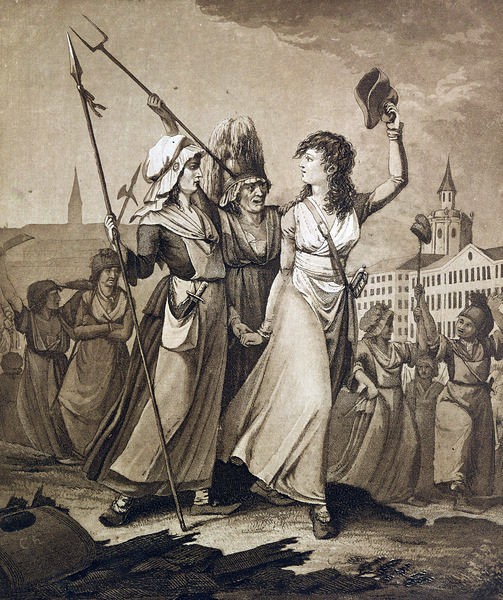women's march on versailles primary sources
The Womens March on Versailles was prompted by the high price of bread food scarcity and by rumors that the Tricolor French flag of the revolution had been trampled on and derided by the royalist troops and Louis XVI on October 1 during a special reception for the Kings. By the time they reached Versailles they had roughly 6000 people.
Original Sources Discover French Revolution March On Versailles
In October 1789 a committee of the National Constituent Assembly carried out an inquiry into the events of October 5th and 6th when a Parisian mob marched on Versailles.

. Womens March to Versailles. In October 1789 thousands of Parisians many of them women embarked on a 12-mile march to Versailles the residence of the French king Louis XVI and the National Constituent Assembly. The March To Versailles 1789 It was early in the morning on October 5 when groups of women had gotten together and made a big crowd in the central marketplace of Paris The march to Versailles with its angry women and their threatening behavior was one of many violent disturbances that.
Bread was very difficult to get and very expen and feeding children seemed like an impossible task. He exaggerates his role in the events but gives a vivid account of the womens march especially their insistence on petitioning the deputies in the National Assembly. To the right of the image a woman is depicted riding on a rearing horse.
Womens March on Versailles Source. Louis the Sixteenth brought back to Paris by the Womens March. She carries what appears to be a switch in her right hand.
I believe in this time women really took a stand in what they needed or believed in. Bibliotheque nationale de France Women in the Marketplace Riot On the morning of October 5 1789 a large group of women in a Paris marketplace began to revolt. They demanded to see the Baker the Bakers wife and the Bakers boy.
Majority of the womens rage was focused on Marie Antoinette due to her. They began to march through Paris demanding bread at a fair price. A famous illustration of Parisian women marching to Versailles October 1789.
Many families gathered and demanded bread for their families as well as discontented Parisians. Library of Congress Serial and Government Publications Division. Driven to desperation by food shortages they hoped the king would intervene but some had.
Joseph Weber et al. Madelaine Glain aged 42 cleaner wife of Francois Gaillard office assistant in the Oratoire district with. On October 5 1789 women had suffered enough injustice as a result of the economic crisis in France.
At first it had been just a lavish hunting lodge but over the. On October 4 1789 a crowd of women demanding bread for their families gathered other discontented Parisians including some men and marched toward Versailles arriving soaking wet from the rain. Once the women reached the entrance to Versailles they were chanting the word bread over and over again to the beat of a drum.
Britains triumph over France in the Seven Years War intensified many of the factors that produced the French Revolution in 1789. The women carry axes pikes a club and firearms mounted with bayonets. The following testimony was given by one of the participants a Madame Madelaine Glain.
This item refers to an event that took place on October 5 1789 when an angry mob of nearly 7000 working women armed with pitchforks pikes and muskets marched in the rain from Paris to Versailles. 1789 The March to Versailles a On Sunday October 4 the people resorted to acts of violence in the public promenades against officers of the army and other individuals who were pointed out to them as aristocrats. Why did they march.
Armed with various weapons including pikes pitchforks and muskets the women began to march. The Greatest Moment in History. Source From Women in Revolutionary Paris 17891795 edited and translated by Darline Gay Levy Harriet Branson Applewhite and Mary Durham Johnson.
The symbol of the power of the kings the great royal Palace at Versailles some fifteen miles from Paris. The building had been begun by Louis IX called the Sun King and continued by his heirs and descendants. WOMENS MARCH ON VERSAILLES editorial October 4 1789 On this day a crowd of women demanded bread for their children.
The King agreed to meet with some of the women and promised to distribute all the bread in Versailles. Your purchase of books or other items through links on this site helps keep this free educational site on the web. A lot of readers will be familiar with the broad strokes of the French Revolution.
The French Revolution Exhibit. On October 5 1789 the women of Paris marched on Versailles with weapons and demands and they changed the course of European history. Men too marched to Versailles.
There was in Paris an extreme agitation. The working class felt neglected by the aristocracy and by the king in particular. The symptoms of a violent insurrection.
Part of Liberté Egalité Fraternité. The Women of Paris March on Versailles. A group of women march from the left in front of a wall.
Womens bread march primary source 1. Helen Johns Kirtland and Lucian Swift Kirtland photographers. World War I Rotogravures 1913-1919.
Food was especially scarce. They wanted to buy bread for their families. Print of the market womens march to Versailles.
Library of Congress Prints and Photographs Division.

The October March On Versailles

French Revolution For Kids Women S March On Versailles

Women S March On Versailles Famous Painting On This Day

The Women S March On Versailles Universal History Archive Uig Via Getty Images Missed In History History History Class

The October March On Versailles

Eyewitness Accounts Of The October Days 1789

Burgerbuddy Ilustraciones Maria Antonieta Arte

Treaty Of Versailles Google Search Actividades De Historia Versalles Tratado De Versalles
